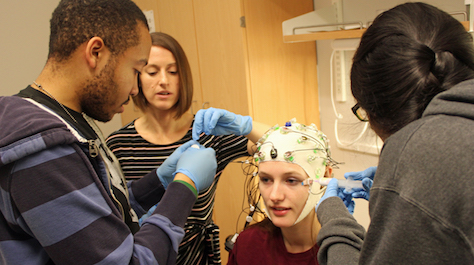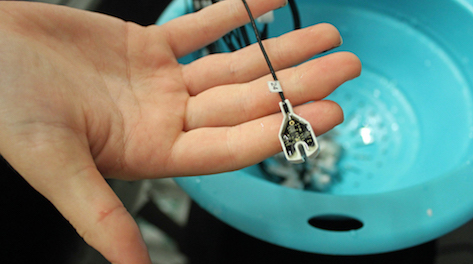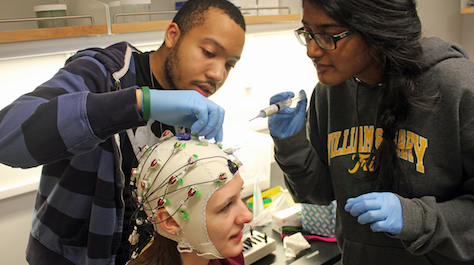What's in a name?
Behind a gray door in the basement of William & Mary’s Integrated Science Center is a narrow hallway that leads to three identical rooms. Each room is furnished with a desk, a chair and a computer monitor.
A lever is bolted to the door of each room. When it closes, the electronic hum of machines, computers and cellphones disappears. The rooms are equipped with copper wiring to minimize interference from any external noise that would disrupt the measurement of electrical signals firing inside the human brain.
Opened in August 2016, the Electroencephalography — or EEG — Lab measures electrical brain activity by employing a series of 32 electrodes placed on a person’s face and scalp. The system monitors the brain’s electrical charge, which is generated by billions of neurons.
Small metal disks, called electrodes, are placed on the scalp and register microvolts of ionic current created when neurons fire off electrical signals. Each electrode site is labeled with a letter and number corresponding to an area of the brain. For example, “F” is for frontal lobe, the region of the brain responsible for motor function, language and memory. The lab comes equipped with multiple EEG devices, which can monitor two brains at once.
“We designed the space with the architect, so it was exactly what we wanted,” said Cheryl Dickter, an associate professor of psychology at William & Mary. “This is pretty state of the art, so it’s really exciting.”
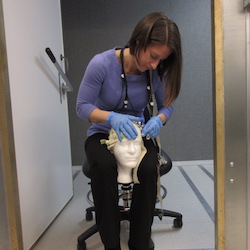 What happens in the EEG lab is a far cry from the leather couch, a cliché that the department — and the profession — is actively moving away from, says Josh Burk, chair of William & Mary's Department of Psychological Sciences.
What happens in the EEG lab is a far cry from the leather couch, a cliché that the department — and the profession — is actively moving away from, says Josh Burk, chair of William & Mary's Department of Psychological Sciences.
The department conducts scientific research in which students and faculty collect data, analyze that data and make conclusions. Visitors to the lab are study participants, who help reveal internal processes occurring inside the brain. There is no Freudian daybed on which to divulge their innermost thoughts.
“Psychology is a discipline where there is this perception that we’re all Dr. Phils,” said Burk, referring to the popular television psychologist. “That’s not the type of work that we do.”
Call it like it is
To highlight the actual work being done in the department, William & Mary’s Department of Psychology officially changed its name to the Department of Psychological Sciences. The new name was approved by the accrediting agency, SCHEV, on July 27, 2017, but the change has been in the works for years, Burk said.
The Department of Psychological Sciences features individual and shared laboratory space to support faculty research, often done with undergraduate and graduate students. For example, there is a shared Cognitive Science laboratory equipped with 12 computers — with the software and hardware required to assess speed and accuracy of task performance, as well as video and sound recording capability to monitor social interaction.
The department’s faculty members are working on a number of international and national collaborations, Burk said. The faculty interact with a variety of fields within William & Mary’s academic community, including the Raymond A. Mason School of Business, School of Education, along with several departments and programs in Arts & Sciences, including Africana studies, applied science, computer science and linguistics. In addition, 10 faculty members in the Department of Psychological Sciences serve as Faculty Affiliates in the Neuroscience Program.
“We’re working to dispel myths about psychology,” Burk said. “I hope that’s something that’s achieved through the name change.”
Burk says the department has always had a strong focus on science. The new name is just catching up with the volume of rigorous, scientific research that faculty and students are already doing.
“It's not like we changed our curriculum to match the new name,” Burk said. “The name really just describes what we've been doing for a long time.”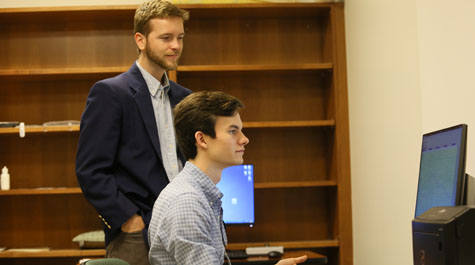 Scientific research plays a key role in the department’s curriculum. The EEG Lab has been an important factor in that research, Burk said. The new system allows researchers to measure electrical brain activity in two individuals at the same time.
Scientific research plays a key role in the department’s curriculum. The EEG Lab has been an important factor in that research, Burk said. The new system allows researchers to measure electrical brain activity in two individuals at the same time.
“This system allows us to do things like look at brain activity during social interaction,” Burk said.
For example, Burk and Dickter recently teamed up to study traits associated with autism, specifically emotional processing. Their experiment asks participants to view a series of faces depicting various emotions. Each participant identifies which emotion they believe each face depicts. Researchers monitor the participant’s reaction time and brain activity and record how they identify each emotion.
"What we're showing is that people with different levels of autistic traits are processing emotional faces differently,” Dickter said.
From their station outside the three EEG rooms, Dickter and Burk track brainwave activity as participants are shown different emotions. The level of activation depends on the type of emotion participants are seeing on the screen in front of them, Dickter said.
“The reaction time someone has in identifying facial displays of anger may depend on their level of autistic traits,” Dickter said. “Learning about the way someone’s brain processes emotions can help us understand what may lead to a difference in reaction time — or in some cases what may lead them not to accurately categorize the emotion at all."
How does that make you feel?
Merriam-Webster defines psychology as “the science of mind and behavior.” The study of human emotion lies at the intersection of both, which may explain why emotional response is featured in a series of current research projects within the department.
Assistant Professor Chris Conway is running a study to figure out whether people can acquire fears vicariously. He invites participants into a lab to watch a video of a stranger looking at shapes on a computer screen. The stranger experiences an electrical shock every time a triangle appears, but is not dealt a shock when other shapes are presented.
“Then we surprise the participant by saying, ‘Now it's your turn. You'll now go through the same procedure as this stranger,’” Conway said.
The team of researchers attaches electrodes to the participant’s skin to monitor physiological fear responses — like sweating, respiration, and heart rate — while the participant is confronted with a series of geometric images. The participant does not receive a shock when triangles appear, but still exhibits signs of fear when confronted with that particular shape.
“We're finding that fears can in fact be transmitted observationally. No direct experience is needed in order to develop the fear,” Conway said. “We think this result will inform theories of the origins and treatment of anxiety disorders like panic, obsessive-compulsive disorder and posttraumatic stress disorder.”
Todd Thrash, a professor of psychology, has been studying another form of emotional contagion: inspiration.
In a study published last year, Thrash and his co-authors, Laura Maruskin '10, Emil Moldovan '14, Victoria Oleynick '15 and Will Belzak '17, found that text written by a writer who feels inspired elicited a comparable state of inspiration in the reader. In other words, inspiration can be infectious.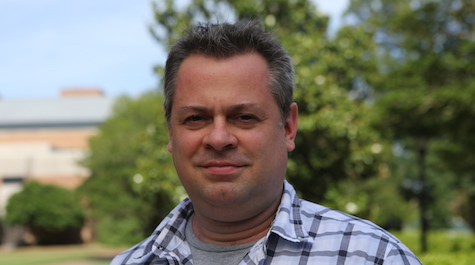 “Contagion of inspiration from writers to readers is a topic that has been of interest to theologians, literary theorists and others outside the sciences — literally for millennia,” Thrash said. “Science has something new to offer to this traditionally unscientific topic.”
“Contagion of inspiration from writers to readers is a topic that has been of interest to theologians, literary theorists and others outside the sciences — literally for millennia,” Thrash said. “Science has something new to offer to this traditionally unscientific topic.”
Thrash and his team of researchers looked for concrete evidence of inspiration spreading between writer and reader. They tested their hypothesis with a group of 195 William & Mary students, each of whom wrote one poem. Then another 220 students read the poems. Each student was asked to self-report their level of inspiration. The researchers found that the most-inspired writers produced the most-inspired readers.
“A given instance of inspiration may have far-reaching cultural implications,” read the study. “The inspired writer participates in the sweep of history, producing a text that is not just valuable but that enlightens, inspires, and raises the hairs on the arms of future generation of thinkers.”
From the lab to the world
Generating theories and testing those theories are vital skills for anyone looking to enter the field of psychology as a clinician or scientist, Burk says. Even if a student plans to open their own counseling practice, their time in the lab will inform decisions they make as a practitioner.
“They pick up research experience, so they are able to take in data, analyze those data and then explain those data to somebody else,” he said. “That's a skillset they can hopefully apply in their practice.”
Dickter says the autism study she and Burk are currently conducting could have larger clinical applications in the future. If a patient has autism or social anxiety, it may be because they are experiencing different patterns of brain activity, she said.
“We’re trying to understand the underlying mechanism that may be contributing to differences in social interactions,” Dickter said.















